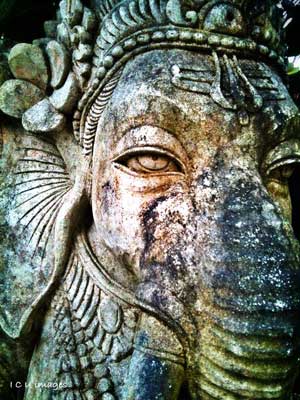
September marks the time of Gaṇeśa Chaturthi, a day associated with the worship of Gaṇeśa. The elephant-headed deity has become loved by many all over the
world. He’s big, friendly, sometimes clumsy and he helps us when we are stuck- who wouldn’t love him. Gaṇeśa is also associated with technology, which
includes our computers. These beneficial devices can cause us great headaches when they get bugs, viruses or just plain don’t do what they are supposed to
be doing. In the ancient days, Gaṇeśa was associated with small machines, and as we see with the Antikythera mechanism, small machines have been around for
a long time. Today, Gaṇeśa is the god of the computer, and just as every image of Gaṇeśa is not complete without a mouse sitting next to him, so our
computers are not complete without a mouse.
Gaṇeśa is one of the best deities to have an image of in the office. I even keep a small sticker on my computer. Gaṇeśa is also a very important energy for
learning, and anyone in school will benefit from his presence. By nature, Gaṇeśa is a mathematical genius, and thinks like a quantum physicist. He
particularly looks over those in the realm of technology, and the technical sciences.
Gaṇeśa also represents the doorway, the beginning, or the access to something new. He can be symbolized by a key, as he is the key that opens the lock that
gets us through.
As the Gaṇeśa has become famous enough to have his image in homes and store fronts around the world, what form is best? There are so many different types
of Gaṇeśa. Here, I want to share an astrological technique to look at which position of Gaṇeśa is the most appropriate for an individual to
approach him.
The twelve houses in astrology are divided into the four aims of life. The dharma houses (fire) indicate a standing form, the artha houses (earth) indicate
a sitting/riding form, the kama houses (air) indicate an active form (walking or dancing) and the mokṣa houses (water) indicate a resting form. From this
we understand that a standing form helps us realize purpose and therefore removes the blocks to achieving our goals. A sitting or riding form is beneficial
for wealth and prosperity. A dancing form is good for all levels of relationship (friendships, family and love). And the form of the resting Gaṇeśa is
calling us to reside within our true nature, thereby removing spiritual blocks.
In the Utkal tradition, we take the house location of Ketu (the south node) and utilize this disposition to understand Gaṇeśa. The house and sign position
indicates one’s root form of Gaṇeśa. Utilizing the house, if an individual has Ketu in the first, fifth, or ninth house, then a standing form is best. If
Ketu is in the second, sixth, or tenth house then a form of him sitting or riding is the best. If Ketu is placed in the third, seventh or eleventh house
then a dancing Gaṇeśa is best. If Ketu is in the fourth, eighth or twelfth house then a reclining Gaṇeśa is best. In general, a sitting (artha) form of
Gaṇeśa is best for the office, and a standing form (dharma) will be best for a yoga studio or school.
Auṁ hrīṁ jyotir-gaṇeṣāya namaḥ